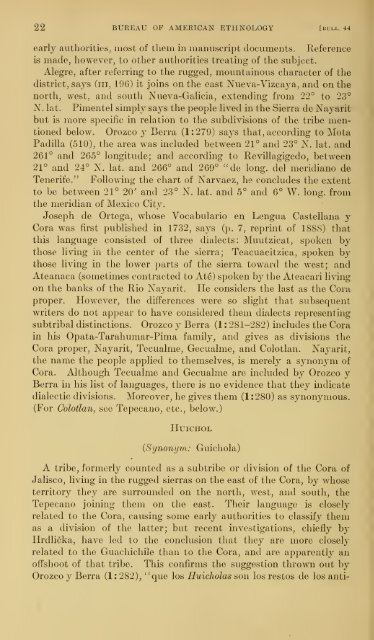Untitled - Smithsonian Institution
Untitled - Smithsonian Institution
Untitled - Smithsonian Institution
You also want an ePaper? Increase the reach of your titles
YUMPU automatically turns print PDFs into web optimized ePapers that Google loves.
22 BUREAU OF AMERICAN ETHNOLOGY [bull. 44<br />
early authorities, most of them in manuscript documents. Reference<br />
is made, however, to other authorities treating of the subject.<br />
Alegre, after referring to the rugged, mountainous character of the<br />
district, says (iii, 196) it joins on tlie east Nueva-Vizcaya, and on the<br />
north, west, and south Nueva-GaUcia, extending from 22° to 23°<br />
N. lat. Pimentel simply says the people lived in the Sierra de Nayarit<br />
but is more specific in relation to the subdivisions of the tribe mentioned<br />
below. Orozco y Berra (1:279) says that, according to Mota<br />
Padilla (510), the area was included between 21° and 23° N. lat. and<br />
261° and 265° longitude; and according to Revillagigedo, between<br />
21° and 24° N. lat. and 266° and 269° "de long, del meridiano de<br />
Tenerife.^' Following the chart of Narvaez, he concludes the extent<br />
to be between 21° 20' and 23° N. lat. and 5° and 6° W. long, from<br />
the meridian of Mexico City.<br />
Joseph de Ortega, whose Vocabulario en Lengua Castellana y<br />
Cora was first published in 1732, says (p. 7, reprint of ISScS) that<br />
this language consisted of three dialects: Muutzicat, spoken by<br />
those living in the center of the sierra; Teacuacitzica, spoken by<br />
those living in the lower parts of the sierra toward the west; and<br />
Ateanaca (sometimes contracted to Ate) spoken by the Ateacari living<br />
on the banks of the Rio Nayarit. He considers the last as the Cora<br />
proper. However, the differences were so slight that subsequent<br />
writers do not appear to have considered them dialects representing<br />
subtribal distinctions. Orozco y Berra (1 : 281-282) includes the Cora<br />
in his Opata-Tarahumar-Pima family, and gives as divisions the<br />
Cora proper, Nayarit, Tecualme, Gecualme, and Colotlan. Nayarit,<br />
the name the people applied to themselves, is merely a synonym of<br />
Cora. Although Tecualme and Gecualme are included by Orozco y<br />
Berra in his list of languages, there is no evidence that they indicate<br />
dialectic divisions. Moreover, he gives them (1:280) as synonymous.<br />
(For Colotlan, see Tepecano, etc., below.)<br />
HUICHOL<br />
{Synonym: Guichola)<br />
A tribe, formerly counted as a subtribe or division of the Cora of<br />
Jalisco, living in the rugged sierras on the east of the Cora, by whose<br />
territory they are surrounded on the north, west, and south, the<br />
Tepecano joining them on the east. Their language is closely<br />
related to the Cora, causing some early authorities to classify them<br />
as a division of the latter; but recent investigations, chiefly by<br />
Hrdlicka, have led to the conclusion that they are more closely<br />
related to the GuachichUe than to the Cora, and are apparently an<br />
offshoot of that tribe. This confirms the suggestion thrown out by<br />
Orozco y Berra (1: 282), ''que los Huicholas son los restos de los anti-

















